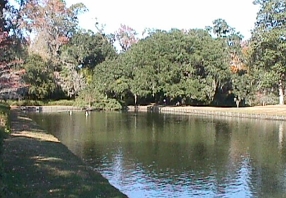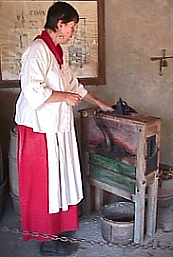Middleton
Place
4300 Ashley
River Rd.
Charleston,
SC
November 18, 2001
Middleton  Place is one of the "living museums"
that we are so fond of. Not only can you visit the beautiful
gardens and buildings, but on many occasions see the past
actually come alive through the interpreters they have exhibiting
different aspects of life on a southern plantation. We found out
that Middleton Place contains some of America's oldest landscaped
gardens. Middleton Place is a proud survivor of the American
Revolution, Civil War, changing fortunes and natural disasters.
First granted in 1675, only five years after the first English
colonists arrived in the Carolinas, this National Historic
Landmark has history, drama,
Place is one of the "living museums"
that we are so fond of. Not only can you visit the beautiful
gardens and buildings, but on many occasions see the past
actually come alive through the interpreters they have exhibiting
different aspects of life on a southern plantation. We found out
that Middleton Place contains some of America's oldest landscaped
gardens. Middleton Place is a proud survivor of the American
Revolution, Civil War, changing fortunes and natural disasters.
First granted in 1675, only five years after the first English
colonists arrived in the Carolinas, this National Historic
Landmark has history, drama, beauty and educational discoveries for everyone
in the family. For over two and a half centuries, these
graciously landscaped gardens have enchanted visitors from all
over the world. You can stroll through vast garden
"rooms," laid out with precise symmetry and balance, to
the climatic view over the Butterfly Lakes and the winding Ashley
River beyond. Today, as they did then, the gardens represent the
Low Country's most spectacular and articulate expression of an
18th century ideal - the triumphant marriage between man and
beauty and educational discoveries for everyone
in the family. For over two and a half centuries, these
graciously landscaped gardens have enchanted visitors from all
over the world. You can stroll through vast garden
"rooms," laid out with precise symmetry and balance, to
the climatic view over the Butterfly Lakes and the winding Ashley
River beyond. Today, as they did then, the gardens represent the
Low Country's most spectacular and articulate expression of an
18th century ideal - the triumphant marriage between man and  nature.
We were able to walk the same footpaths through these gardens as
did pre-Revolutionary statesmen, and enjoy the same vistas that
inspired four generations of the distinguished Middleton family
from 1741 to 1865. Here lived Henry Middleton, President of the
First Continental Congress; Arthur Middleton, a signer of the
Declaration of Independence; Henry Middleton, Governor of South
Carolina and later Minister to Russia; and Williams Middleton, a
signer of the Ordinance of Secession.
The main house, which is now in ruins, dates to the late 1730s,
and with some
nature.
We were able to walk the same footpaths through these gardens as
did pre-Revolutionary statesmen, and enjoy the same vistas that
inspired four generations of the distinguished Middleton family
from 1741 to 1865. Here lived Henry Middleton, President of the
First Continental Congress; Arthur Middleton, a signer of the
Declaration of Independence; Henry Middleton, Governor of South
Carolina and later Minister to Russia; and Williams Middleton, a
signer of the Ordinance of Secession.
The main house, which is now in ruins, dates to the late 1730s,
and with some  200 surrounding acres was part of the dowry
brought by Mary Williams to her marriage to Henry Middleton in
1741. Almost immediately Henry began establishing the gardens; in
1755, he further improved the property with the construction of
two dependencies, or flankers, one on either side of the
three-story brick house. The north flanker (which was originally
intended as a gentlemen's guest wing) contained a library of
leather-bound volumes plus many oil and watercolor paintings,
prints and other objets d'art. A music room may have been housed
in the north flanker as well. The plantation office was located
downstairs in the south flanker with additional sleeping space
upstairs for visiting friends
200 surrounding acres was part of the dowry
brought by Mary Williams to her marriage to Henry Middleton in
1741. Almost immediately Henry began establishing the gardens; in
1755, he further improved the property with the construction of
two dependencies, or flankers, one on either side of the
three-story brick house. The north flanker (which was originally
intended as a gentlemen's guest wing) contained a library of
leather-bound volumes plus many oil and watercolor paintings,
prints and other objets d'art. A music room may have been housed
in the north flanker as well. The plantation office was located
downstairs in the south flanker with additional sleeping space
upstairs for visiting friends and family. Unfortunately, in February of 1865
Union troops set fire to the main house of Middleton Place
burning the house and north flanker beyond repair. However, the
less severly damaged south flanker was restored by the family in
1869-1870 to be their residence. Today the only remaining
building, the north flanker, contains family furniture, paintings
and books; most of the objects date from the 1740s through 1880s.
This collection tells the story of the men, women and children
who made Middleton Place their home for over two centuries. Some
of the paintings include works by Benjamin West and Thomas Sully.
After touring the house we were able to take in the colorful
sights and sounds of the working plantation stableyards. They had
crafts-people demonstrate the skills performed by slaves in the
18th and 19th centuries, surrounded by the domestic animals who
work and live among them. This was the first time Bob or I had
seen how they processed rice in the past. The people who did the
demonstrations were very knowledgeable in their areas. It was
fascinating to watch.
and family. Unfortunately, in February of 1865
Union troops set fire to the main house of Middleton Place
burning the house and north flanker beyond repair. However, the
less severly damaged south flanker was restored by the family in
1869-1870 to be their residence. Today the only remaining
building, the north flanker, contains family furniture, paintings
and books; most of the objects date from the 1740s through 1880s.
This collection tells the story of the men, women and children
who made Middleton Place their home for over two centuries. Some
of the paintings include works by Benjamin West and Thomas Sully.
After touring the house we were able to take in the colorful
sights and sounds of the working plantation stableyards. They had
crafts-people demonstrate the skills performed by slaves in the
18th and 19th centuries, surrounded by the domestic animals who
work and live among them. This was the first time Bob or I had
seen how they processed rice in the past. The people who did the
demonstrations were very knowledgeable in their areas. It was
fascinating to watch. After doing all the gardens we sat down to an enjoyable lunch at
the Middleton Place Restaurant where they served an authentic Low
Country lunch. Dinner is also available.
If you're interested in staying nearby they have the Inn at
Middleton Place which is only a short walk from the gardens. The
Inn is in a lovely secluded woodland setting. They offer
horseback riding, kayaking and nature hikes for their guests. I
have to say that no visit to Charleston is complete without a
visit to Middleton Place. If you would like to find out more,
drop by their website at: http://www.middletonplace.org.
After doing all the gardens we sat down to an enjoyable lunch at
the Middleton Place Restaurant where they served an authentic Low
Country lunch. Dinner is also available.
If you're interested in staying nearby they have the Inn at
Middleton Place which is only a short walk from the gardens. The
Inn is in a lovely secluded woodland setting. They offer
horseback riding, kayaking and nature hikes for their guests. I
have to say that no visit to Charleston is complete without a
visit to Middleton Place. If you would like to find out more,
drop by their website at: http://www.middletonplace.org.